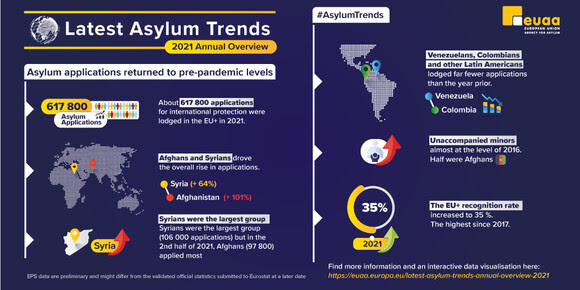After an unusually low number in 2020, asylum applications in EU+ countries increased by a third in 2021, largely during the second half of the year. This was driven mainly by considerably more Afghan and Syrian applications.
The other main countries of origin such as Iraq (some 28 700 applications in 2021), Pakistan (24 600), Turkey (23 700) and Bangladesh (20 000) also lodged more applications than in 2020. Somalis, Nigerians, Moroccans and others from East, West and North Africa also applied in substantially higher numbers. In contrast, Venezuelans, Colombians and other Latin Americans lodged far fewer applications in 2021 than a year earlier. Among European applicants, Belarusians tripled their applications, whereas those by nationals of North Macedonia increased fourfold.
The EU+ recognition rate for EU-regulated forms of protection (refugee status and subsidiary protection) increased to 35 % in 2021, the highest since 2017. This was driven by Afghans, whose recognition rate rose substantially: from 53 % in 2020 to 66 % in 2021, temporarily exceeding 90 % in October and November 2021. Recognition rates were also comparatively high for Eritreans (81 %), Yemenis (79 %), Belarusians (75 %) and Syrians (72 %). Almost two thirds of positive-decision recipients were granted refugee status in 2021, while the remainder were granted subsidiary protection.
For more information and an interactive data visualisation, please visit the Latest Asylum Trends page.


















